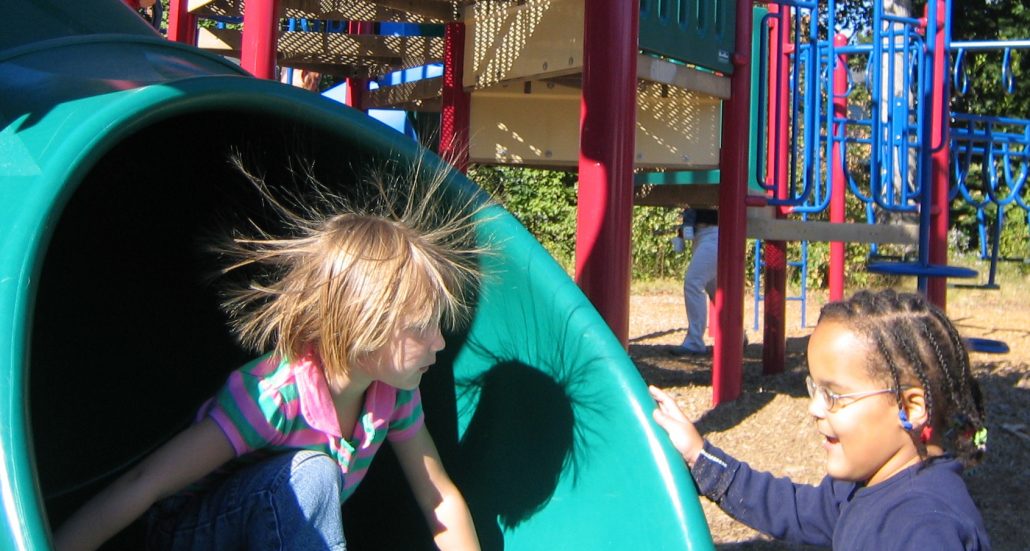Vitamin can keep electronics ‘healthy’
Vitamin E prevents the buildup of static electricity that can harm — even destroy — electronics

The hairs on this girl’s head all carry the same type of charge — which is why they are trying to stay away from each other. This is an example of static electricity, and chemists report they’ve found a way to stop it using a vitamin.
Chris Darling/Wikipedia
Vitamin E has gained respect among nutrition scientists for its ability to fight biologically damaging molecular fragments. These are known as free radicals. In the body, they can promote inflammation, which can harm the heart and blood vessels. A study now shows the same chemical can provide benefits to tiny electrical circuits. Again, the vitamin appears to work by fighting radicals. But in this case, they prevent the buildup of static electricity.
That’s important because a discharge of this type of electricity can be the kiss of death, especially for tiny electronic components.
Static electricity occurs when an electric charge builds up on some surface. This can arise when materials meet and separate. Rub a balloon on your head, for instance. The attractive charge that accumulates can make the balloon stick to a wall. Clothes that tumble in the dryer can develop “static cling” because of the excess charge they pick up. Shuffle across a carpeted floor in winter, and the contact between your socks and the carpet can cause a charge to build up on your body. Reach for a metal doorknob, and zap! As your hand touches the metal, you’ll feel that short, sharp shock. That’s the electricity discharging, as it tries to balance out between you and the metal.
Such instances of static electricity amount to little more than a nuisance. But when those same charges build up in electronic devices, the result can be catastrophic. Even a relatively small static discharge within a computer can ruin a computer chip, start a fire or cause an explosion.
“These things happen all the time,” Fernando Galembeck told Science News. Galembeck is a physical chemist at the University of Campinas in Brazil. He did not work on the new study.
Because static discharge poses such a big risk to electronics, chemists have been investigating ways to stop it. Bilge Baytekin and her coworkers at Northwestern University in Evanston, Ill., began probing how static electricity forms. They worked with polymers. These are materials built from long strings of identical molecules. Because electric charges don’t move across or through polymers, any charge that builds up on them will stay put.
On polymers, those charges come with buddies, called free radicals. These uncharged molecules hold the charges in place. Until now, Baytekin says, scientists had never seriously studied the role of radicals in static electricity. She said scientists’ attitude had been, “‘Oh, radicals are uncharged, we don’t care about them.’”
In fact, those radicals proved critical, her group reported in the Sept. 20 Science. And that suddenly made vitamin E look like a possible treatment for vulnerable circuits. The nutrient has a well-known ability to scavenge, or wipe out, radicals. (Indeed, that scavenging ability is why the vitamin has been so attractive in fighting inflammation in the body.)
The scientists dipped their test polymers in solutions that contained a radical scavenger, like vitamin E. They compared those polymers to some that hadn’t been dipped. The charges on the vitamin-enriched polymers went away much faster than the charges on the non-dipped polymers. The researchers believe that’s because the vitamin mopped up the radicals. And without the radicals to hold the charges in place, static electricity no longer built up. The study suggests that such a low-cost treatment could avoid a potentially catastrophic static buildup in electronics.
Baytekin suspects these scavengers may help in other ways, too. Hairdressers take note: A comb dipped in a vitamin E solution might even prevent flyaway hair, which is due to a static-charge buildup. Of course, she hasn’t tested that. Yet.
POWER WORDS
chemistry A science that deals with the composition, structure and properties of substances and with the changes that they go through. Chemists use this knowledge to study unfamiliar substances, to reproduce large quantities of useful substances, or to design and create new and useful substances.
electric charge The physical property responsible for electric force; it can be negative or positive.
physical chemistry The area of chemistry that uses the techniques and theories of physics to study chemical systems.
polymer A molecule made by linking many smaller molecules. Examples include plastic wrap, car tires and DVDs.
radical A charged molecule having one or more unpaired outer electrons. Radicals readily take part in chemical reactions.
vitamin Any of a group of chemicals that are essential for normal growth and nutrition and are required in small quantities in the diet because they cannot be made by the body.







